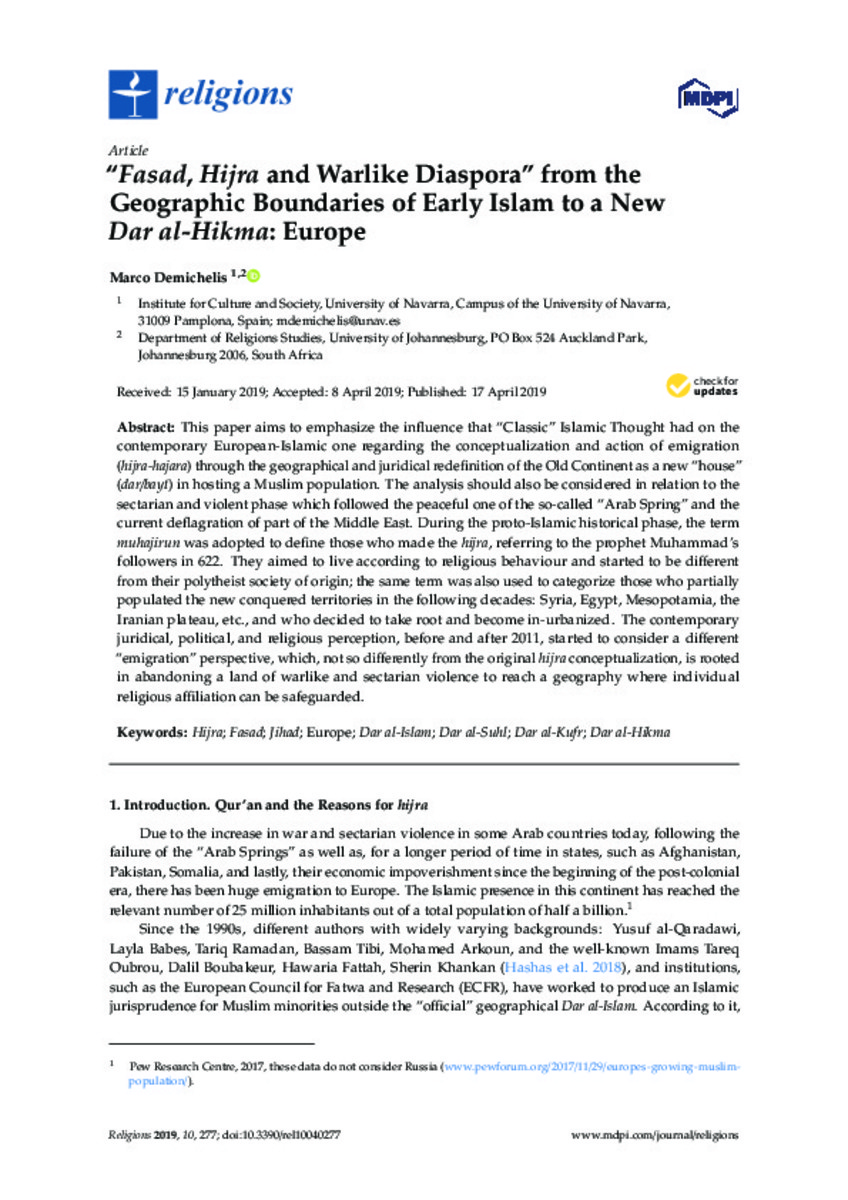Full metadata record
| DC Field | Value | Language |
|---|---|---|
| dc.creator | Demichelis, M. (Marco) | - |
| dc.date.accessioned | 2019-06-06T12:18:17Z | - |
| dc.date.available | 2019-06-06T12:18:17Z | - |
| dc.date.issued | 2019 | - |
| dc.identifier.citation | Demichelis, M. (Marco). "“Fasad, Hijra and Warlike Diaspora” from the Geographic Boundaries of Early Islam to a New Dar al-Hikma: Europe". Religions. 10 (4), 2019, 277 | es |
| dc.identifier.issn | 2077-1444 | - |
| dc.identifier.uri | https://hdl.handle.net/10171/57762 | - |
| dc.description.abstract | This paper aims to emphasize the influence that “Classic” Islamic Thought had on the contemporary European-Islamic one regarding the conceptualization and action of emigration (hijra-hajara) through the geographical and juridical redefinition of the Old Continent as a new “house” (dar/bayt) in hosting a Muslim population. The analysis should also be considered in relation to the sectarian and violent phase which followed the peaceful one of the so-called “Arab Spring” and the current deflagration of part of the Middle East. During the proto-Islamic historical phase, the term muhajirun was adopted to define those who made the hijra, referring to the prophet Muhammad’s followers in 622. They aimed to live according to religious behaviour and started to be different from their polytheist society of origin; the same term was also used to categorize those who partially populated the new conquered territories in the following decades: Syria, Egypt, Mesopotamia, the Iranian plateau, etc., and who decided to take root and become in-urbanized. The contemporary juridical, political, and religious perception, before and after 2011, started to consider a different “emigration” perspective, which, not so differently from the original hijra conceptualization, is rooted in abandoning a land of warlike and sectarian violence to reach a geography where individual religious affiliation can be safeguarded. | es_ES |
| dc.description.sponsorship | This project has received funding from the European Union’s Horizon 2020 research and innovation programme under the Marie Skłodowska-Curie grant agreement No 746451 | - |
| dc.language.iso | eng | es_ES |
| dc.publisher | MDPI | es_ES |
| dc.relation | info:eu-repo/grantAgreement/EC/H2020/746451/EU | - |
| dc.rights | info:eu-repo/semantics/openAccess | es_ES |
| dc.subject | Hijra | es_ES |
| dc.subject | Europe | es_ES |
| dc.subject | Fasad | es_ES |
| dc.subject | Dar al-Islam | es_ES |
| dc.subject | Jihad | es_ES |
| dc.subject | Dar al-Suhl | es_ES |
| dc.subject | Dar al-Kufr | es_ES |
| dc.subject | Dar al-Hikma | es_ES |
| dc.title | “Fasad, Hijra and Warlike Diaspora” from the Geographic Boundaries of Early Islam to a New Dar al-Hikma: Europe | es_ES |
| dc.type | info:eu-repo/semantics/article | es_ES |
| dc.description.note | This article is an open access article distributed under the terms and conditions of the Creative Commons Attribution (CC BY) license | es_ES |
| dc.identifier.doi | 10.3390/rel10040277 | - |
| dadun.citation.number | 4 | es_ES |
| dadun.citation.publicationName | Religions | es_ES |
| dadun.citation.startingPage | 277 | es_ES |
| dadun.citation.volume | 10 | es_ES |
Files in This Item:
Statistics and impact
Items in Dadun are protected by copyright, with all rights reserved, unless otherwise indicated.






